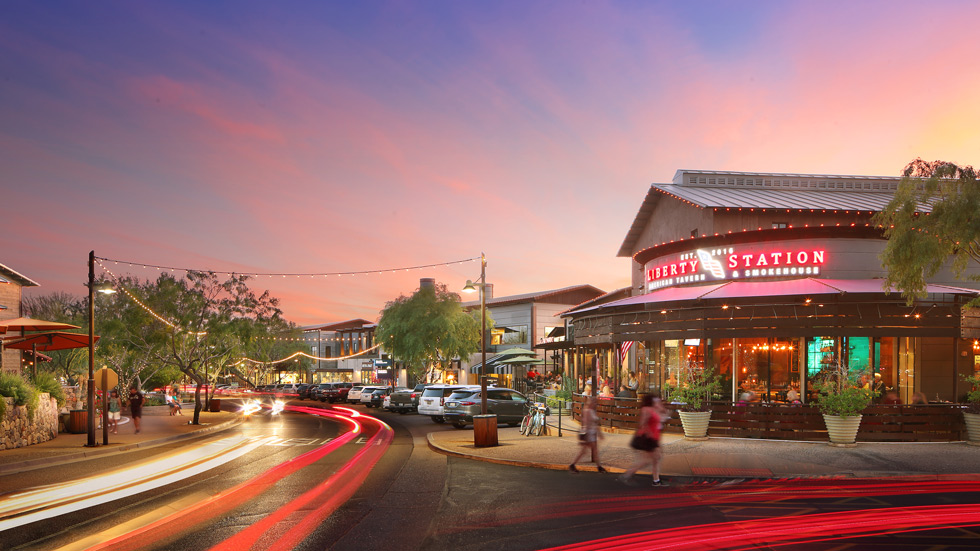With a focus on building solid community connections and deep tenant relationships, Whitestone REIT (NYSE: WSR) sees strong growth and income potential for its Sun Belt-focused portfolio of open-air shopping centers.
Houston-based Whitestone acquires, owns, manages, develops, and redevelops high-quality neighborhood centers primarily located in Houston, Dallas, Austin, Fort Worth, San Antonio, and Phoenix/Scottsdale.
The company’s strategy revolves around creating local connections between consumers in the communities surrounding its properties, and creating a well-crafted mix of local, regional, and national tenants that provide daily necessities, needed services, entertainment, and experiences.
At the beginning of 2022, Whitestone announced several leadership changes, including Dave Holeman taking over as CEO after previously serving as CFO. Christine Mastandrea was named as COO, and Scott Hogan as CFO.
“We really re-committed to where we were, in terms of strategy with a heightened focus on listening to our clients, and their customers, and the investment community” Holeman says. “The changes we announced were primarily around governance, investor engagement, and balance sheet improvement.”
Additionally, the company announced a right-sizing of management compensation and set a goal to grow its 2022 FFO per share in the 16% range over 2021 levels.
Shift in Focus
In 2006, several members of the current executive team joined Whitestone when it was public but non-traded. At that time, the company was much smaller and had a non-cohesive mix of commercial real estate assets.
“Beginning that year, we adopted a business model that made us a little different in the retail REIT segment, focusing on a tenant mix that was compatible with what was going on with the shift to online retailing, and focusing on smaller spaces,” Holeman says. “From 2006 to today we have grown the company from approximately $150 million in assets to about $1.5 billion.”
It was during this time that the company also started transitioning assets and tenants that weren’t part of this new philosophy.
Mastandrea characterizes the shift due to the “Amazon effect,” so instead of focusing on the typical power centers and malls, Whitestone wanted to focus more on community and services.
“We thought that would be better to serve the communities by having grocery, food, health, wellness and fitness, entertainment, education, and then basic services like UPS,” she says. “We love franchises, and instead of going towards big box and hard goods and soft goods, we went in the opposite direction.”
Therefore, instead of destination shopping, the company looked for high-visit places where people would go daily to weekly, be it a Montessori school, gym, or pizza place.
In addition to that strategy, Whitestone focused on certain markets of growth. For instance, one of the things it saw happening in the Midwest was structural constraints and realized that in certain markets—especially Texas—it made sense to invest more.
“With that, we started buying in Dallas, Austin, San Antonio, and given the financial crisis, we also saw a great opportunity to buy in Arizona,” Mastandrea says.
Geographic Philosophy
One of the things that Holeman says differentiates Whitestone from other retail center REITs is its best-in-class geographic focus, operating in some of the largest and fastest-growing metropolitan statistical areas (MSAs.)
“Almost 100% of our portfolio is in suburban areas within top 10 metro areas in the Sunbelt,” he says. “The locations we’ve targeted are business-friendly states that have a lower cost of living, a lower unemployment rate, encourage business growth, are less regulated, and tend to be more landlord-friendly.”
That allows Whitestone to be active managers of its real estate. The Phoenix submarket represents approximately 40% of Whitestone’s portfolio, with the remaining 60% in Texas, including Austin, which is the fastest growing MSA in the country.
The populations in the MSAs Whitestone operates in have grown by more than double the national rate, with jobs added at three times the national rate between 2010-2020.
“We always look for locations that have good traffic levels, high household incomes surrounding the properties, and we like the suburban areas,” Holeman says. “We continue to see the work-from-home initiative benefit our locations.”
Mastandrea adds that the company also looks at job growth figures in an area, and what’s seeding that growth.
“Education plays well into that. In Texas, we saw the educational systems changing over the last 20 years and see other states starting to follow that, such as Arizona,” she says. “The quality of the workforce is very important because that’s where you will see job growth and it translates into higher disposable dollars spent in our centers.”
While the centers are smaller—averaging around 100,000 square feet—Whitestone likes to own a grouping of centers in favorable trade area locations, looking to cover the high-traffic corners.
Creating Value
Whitestone also looks to value-add with its centers and feels some of the best opportunities are under-leased properties which can be improved both in the look, functionality, and merchandising mix.
“That’s where we’ve had a lot of opportunities, especially in Arizona, where we found low occupancy rates but great locations,” Mastandrea says. “We try to avoid deep boxes, that’s really important to us because it’s very hard to retrofit anything more than 75-feet deep.”
The typical tenant space size at a Whitestone center is 2,500 square feet, which matches well with its current users and the demand it is seeing in the market.
“We use a lot of data to really analyze and know neighborhoods,” Hogan says. “We look for traffic levels, types of population, and then we put together the tenant mix. But beyond the data, we have boots on the ground—teams of people who know the markets, shop there, and go to restaurants at the properties.”



